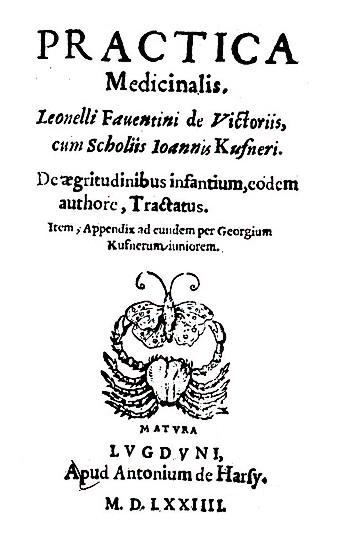Lessico
Leonello Vittori
Secondo
Lind![]() (1963) probabilmente si tratta di Leonello dei Vittori da Faenza, del
quale nel 1544 fu pubblicato il De aegritudinibus infantium. Troviamo
un’altra edizione del trattato di Leonello: Leonellus Faventinus de
Victoriis, Practica medicinalis et tractatus de aegritudinibus infantium
cum Appendix ad eundem - per
Georgium Kufnerum Juniorem. Lugdun. apud Vencentium, 1574.
(1963) probabilmente si tratta di Leonello dei Vittori da Faenza, del
quale nel 1544 fu pubblicato il De aegritudinibus infantium. Troviamo
un’altra edizione del trattato di Leonello: Leonellus Faventinus de
Victoriis, Practica medicinalis et tractatus de aegritudinibus infantium
cum Appendix ad eundem - per
Georgium Kufnerum Juniorem. Lugdun. apud Vencentium, 1574.


La recensione trovata nel web relativa alla prima pubblicazione (1544) suona così: “One of the earliest textbooks of its kind, and unique in that it is a handbook of treatment rather than a treatise on diseases, hence its importance in understanding the medical paediatric practices of the era. "Leonelli's book consists of 33 chapters mostly on common diseases such as diarrhoea, constipation, earache, abscesses of the head, weak stomach, disturbed sleep. His method is simple. He names the disease, gives its cause and then proceeds to its cure. It is really a handbook of paediatric therapeutics and he makes much of fomentations, inunctions, and the external use of oils.”
Leonello viene citato anche da C.E. Kellett, M.D.,
M.R.C.P. in un articolo intitolato Sir Thomas Browne and the disease called
the Morgellons (Annals of Medical History, n.s., VII (1935), 467-479). Si
trattava verosimilmente di una forma di scabbia![]() ,
dovuta al Sarcoptes scabiei, e Kellet conclude così la sua lunga
ricerca: “It is suggested that the disease called by him [Sir Thomas Browne]
the Morgellons is a disease that caused considerable interest in the
seventeenth and eighteenth centuries, known under a variety of names such as
Les Crinons, Masclous, Masquelons, from which it is suggested the name of
Morgellons is derived.”
,
dovuta al Sarcoptes scabiei, e Kellet conclude così la sua lunga
ricerca: “It is suggested that the disease called by him [Sir Thomas Browne]
the Morgellons is a disease that caused considerable interest in the
seventeenth and eighteenth centuries, known under a variety of names such as
Les Crinons, Masclous, Masquelons, from which it is suggested the name of
Morgellons is derived.”
Kennet riferisce quanto segue a proposito di Leonello:
«The edition of Schenckius' "Observat. medicae rarae," that is recorded in Ballard's catalogue, is of Frankfort, 1610, and in view of the many subsequent editions, must almost certainly have belonged to Sir Thomas Browne. Schenckius, having discussed the Dracunculus, known to the Arabians, in his VII Observation, Lib. V, in his VIIIth deals with
“...Worms or, as others will have it, Hairs, which are wont to infest the muscles of the arms, calves, and back in infants and children, and which are unknown to the old authorities...”
and prefaces his own description of the condition with that given by Kufner in his appendix to the book on Diseases of Infants, written by Leonellus Faventinus de Victoriis. This runs as follows:
“There exists in little children certain living principles having the appearance of worms, that are called by the common folk Dracontia. They settle especially in the muscular parts of the body, to wit the arms and legs — the calves especially. Occasionally they even congregate in the flanks under the skin, and sometimes occupy the whole of the back, or failing that at least the interscapular region. These little creatures have this property that, unless they are extirpated by the appropriate remedies, they lead either to a hurtful suppuration, or else forthwith cause the child to waste. We destroy worms of this type, that are in the habit of lurking in the pores of infants and little girls, with this cure. Should they fail to become more prominent, that is should they, having applied warm fomentations and smeared on an edulcent (such as Melicraton) and spice, not thrust out their heads, then they must be positively shaken into coming out into the open. Take as much of the root of the wild vine, or of the white vine, as may be pressed into one hand: Boil this in a lye made from properly mixed oak charcoal. With this the whole body of the child, and at the same time the worms, should be sprinkled and washed. Having done this the mouths of the Dracontia which will have advanced forward are to be shaved off with a razor. When these have been beheaded in this manner, the child should be cleansed afresh from the aforesaid lotion by bathing in castor oil, and should then be washed and the exposed, and possibly cut, skin smeared all over with Syrian salve.”
This book of Faventinus, together with the appendix of Kufner, was first published in 1544, and it is probable that this constitutes the first description of the condition. Yet George Kufner junior, who probably deserved Still's rather caustic comments, is almost alone in confusing this condition with the Dracunculus described by the Arabs, and does not appear to have realized this priority of his.»